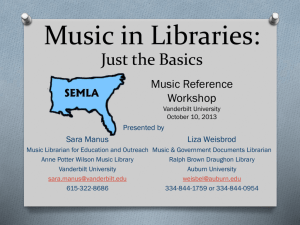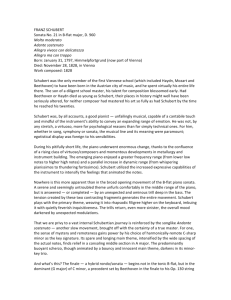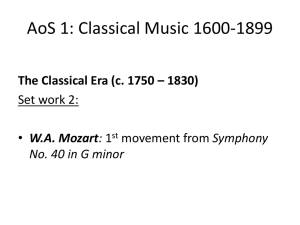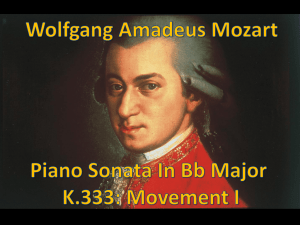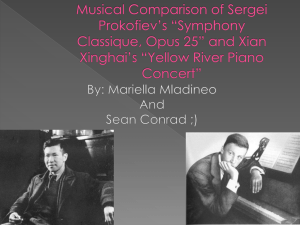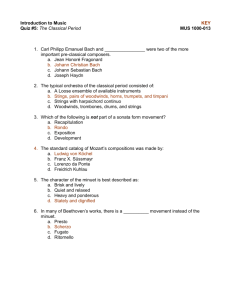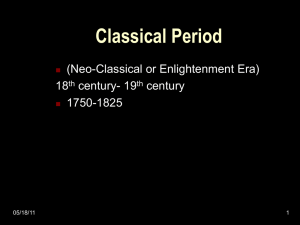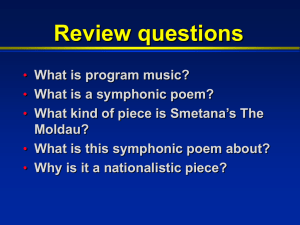Second Semester Music Terms
advertisement
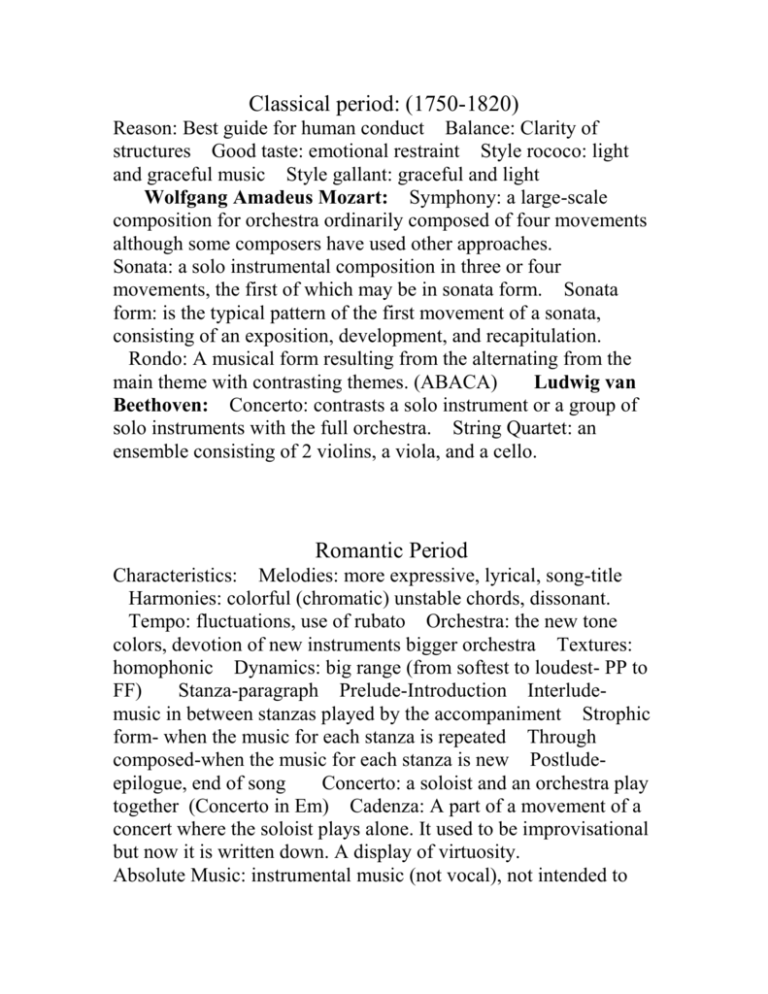
Classical period: (1750-1820) Reason: Best guide for human conduct Balance: Clarity of structures Good taste: emotional restraint Style rococo: light and graceful music Style gallant: graceful and light Wolfgang Amadeus Mozart: Symphony: a large-scale composition for orchestra ordinarily composed of four movements although some composers have used other approaches. Sonata: a solo instrumental composition in three or four movements, the first of which may be in sonata form. Sonata form: is the typical pattern of the first movement of a sonata, consisting of an exposition, development, and recapitulation. Rondo: A musical form resulting from the alternating from the main theme with contrasting themes. (ABACA) Ludwig van Beethoven: Concerto: contrasts a solo instrument or a group of solo instruments with the full orchestra. String Quartet: an ensemble consisting of 2 violins, a viola, and a cello. Romantic Period Characteristics: Melodies: more expressive, lyrical, song-title Harmonies: colorful (chromatic) unstable chords, dissonant. Tempo: fluctuations, use of rubato Orchestra: the new tone colors, devotion of new instruments bigger orchestra Textures: homophonic Dynamics: big range (from softest to loudest- PP to FF) Stanza-paragraph Prelude-Introduction Interludemusic in between stanzas played by the accompaniment Strophic form- when the music for each stanza is repeated Through composed-when the music for each stanza is new Postludeepilogue, end of song Concerto: a soloist and an orchestra play together (Concerto in Em) Cadenza: A part of a movement of a concert where the soloist plays alone. It used to be improvisational but now it is written down. A display of virtuosity. Absolute Music: instrumental music (not vocal), not intended to tell a story, and has no descriptive titles. (A.k.a. non-program music) Incidental Music: Instrumental, which is written as accompaniment for a play or movie. The music sets the mood, enhances the drama, and helps to tell the story. Felix Mendelssohn (1809-1847) Mendelssohn: He was German, and was a conductor and composer. Mendelssohn composed music for Shakespeare's plays. (Midsummer Night's Dream) He was the first to stand on the left as the main violinist becoming a leader. It evolved into a conductor, which has the notes without an instrument to make sure the orchestra plays together. He opened a conservatory, discovered Bach and brought his music back to life. Critics did not consider him a serious composer because he did not live a tragic life. If not a good composer then he was a good conductor, had the conservatory and if that was still not enough, he is known for discovering Bach and bringing the music back to life. (Read biography for more details) Frederic Chopin (1810-1849) Rubato: (robbed) you make a measure longer by stealing a second from the next and speed up for the second measure to show change in mood, intensity and expression. Nocturne: A slow lyrical intimate composition for piano. (Nocturne in Eb) Waltz: A dance in triple meter. It was very popular at that time. People did not dance to Chopin’s waltz because the speed constantly changes from slow to fast. (waltz in C#m) Mazurka: faster and jumpier than a waltz. Etude: an exercise, study piece. A piece to help performers master a specific technical difficulties. (Etude #10) Polonaise: A dance in triple meter but with the qualities of a march. Originated as a stately processional but later became a dance. (Polonaise in Ab) Chopin: exclusively wrote for piano, studied in Warsaw and then moved to France. At the age of 6 he heard his mother play and at 7 started his lessons. After two months he began to perform. Died at the age of 39 from tuberculosis. He was very popular and made a living by giving lessons but only gave lessons to very serious students. He had original methods for teaching. He used the tones and pedals. Absolute music: Friends would give a descriptive title but then he would change it. He loved Bach and Mozart. Mozart’s requiem was played at his funeral. He loved to play in intimate atmospheres because large audiences made him nervous. His music is special because he used the piano as percussion. He would hit the keys to get a good sound but sometimes he did not hit rhythmically. His music was like a story being told. The pedals would continue the sound and used that method to have his pieces sound like songs because the piano was continuous. His music requires a lot of artistry. Franz Schubert (1797-1828) Lied (Lieder): Romantic art song with German text for a voice and piano accompaniment. Most were composed for poems. Schubert: composed music in all forms except concertos, over 600 songs (Lieder), innovator in piano accompaniment, very poor, parents were against him going into music but he wanted it as a profession, they thought he would not be successful because Mozart’s music was still alive and they thought it would be hard for him to stand out, 10 symphonies, 140 songs in one year, his operas were bad, his songs survived, unfinished symphony (really is finished but unlike other symphonies that usually have 4 movements this one only has 2). When he went to meet Beethoven who was deaf, his friend insisted that Schubert meet him. Schubert was shy and did not say anything. He had no business sense, one concert in his life, he was called a “mushroom”- sweet nickname by his friends. He was born in Vienna. The Erlking: it was the most famous poem that he composed a song to. The poem was by Goethe. The poem is about a father taking his son to the doctor. His son sees a vision of the angel of death who is the king of the elves. The king tries to persuade the boy to come with him and his daughters will wait on him. The boy tells the father what he sees and when the father reaches the place the boy is already dead. Strophic Form: A song where the music for each stanza is the same. Through Composed Form: A song where each stanza has new music. (The Erlking) Program Music: Program Music: Is instrumental music, not vocal, which has an intended association that tells a story, which can be based on a book, dream, etc. It has a descriptive title and the composer tells us the story Program symphony: A symphony with a program (has a story). It usually has 4 or 5 movements and each of them has a story. Each movement has a descriptive title/subtitle but the music does not have words. (Symphonie Fantastique: Ball Waltz & Dream of Witches’ Dinner) Concert overture: One movement orchestral composition usually in sonata allegro form, which is based on a story. Symphonic poem: is one of the most important types of program music, having a literary or pictorial connection. Hector Berlioz: (1803-1869) Idee fixe: a recurring theme. It represents his beloved throughout the five movements. (Symphonie Fantastique: Ball Waltz & Dream of Witches’ Dinner) Nationalism in 19th century Nationalism: when a composer deliberately uses melodies from his folk/mother country that inspires him. Every village has there own tunes. Exoticism: When a composer hears a tune from a foreign country that has its own story in that ethnic group and brings it to his own country and introduces it to the people of his own mother country. They would introduce those new tunes into their music and give the music a different feel. Peter Ilych Tchaikovsky (1840-1893) Concert overture: see program music Symphonic poem: see program music Romeo and Juliet and Symphony #4, IV movement Giuseppe Verdi (1813-1901) La donna e mobile and La Cortigiani His last three operas were: Aida, Otello, and Falstaff. He wrote music based on Rigoletto by Victor Hugo (who also wrote The Hunchback of Notre Dame). Rigoletto was the hunchbacked jester of the Duke of Mantua (for those who care Mantua was also known as the place to which Romeo was exiled). Rigoletto helps the abduct women and take them to the Duke. Once his own daughter Gilda is abducted he decides to stop. He tells his daughter to disguise herself, and meet him in Verona. Rigoletto and Gilda go to an inn so they can speak to Sparafucile, a professional assassin. Rigoletto pays Sparafucile to kill the Duke, but Sparafucile's sister Maddalena begs him to kill Rigoletto instead. He says no, but he'll kill the next person who will come to the inn. Gilda hears this and walks in to save the Duke. She is killed and her body is put in a bag. Rigoletto comes back to the inn to get the body and on his way to dump it in the river he hears the supposedly dead Duke's voice. He opens the bag to find his daughter. Rigoletto cries that Monterone's curse has been fulfilled. Impressionism Impressionism: a musical style, made popular during the late 19th and early 20th centuries. Structure was not the point of focus so much as harmony. Rules of tonality and the underlying chords of classical music changed dramatically. Claude Debussey (1862-1918) Whole-tone scale: a scale consisting of six consecutive whole tones. (Sirenes) Maurice Ravel (18751937) Ostinato: indicates a part, which repeats the same rhythmic or melodic element over and over, usually below the main melody of the composition. (Bolero) The Twentieth Century Expressionism: An early 20th-century musical style, employing an abstract approach to music, unlike impressionism. Igor Stravinsky: (1882-1971) Neoclassicism: an artistic movement in 1920's to 1950's characterized be emotional restrain balance clarity. (The Rite of Spring) Polyphonic textures with 20th century rhythm and harmonies. Polychord: two chords sounding together. Is also referred to as polytonal. Polyrhythm: occurs when one or more rhythmic patterns are played simultaneously against the established time signature or meter. Polytonality: the simultaneous use of two or more keys within one composition. Arnold Schoenberg (1874-1951) Expressionism: see 20th century 12-tone system: A system of composition, which uses the twelve tones of the chromatic scale in an arbitrary arrangement, called a tone row or series. The row may be used in its original form, its inversion, in retrograde, and in the inversion of the retrograde. Arnold Schoenberg devised the system in the early 20th century. Tone row: special ordering of the twelve tones. Atonality: absence of the main key. Sprechstimme: style of vocal performance half way between singing and speaking. (A Survivor from Warsaw 1947) George Gershwin (1898-1937) Rhapsody in Blue & Summertime from Porgy and Bess Aaron Copland (1900-1990) Simple Gifts from the Appalachian Spring Leonard Bernstein (1918-1990) America from West Side Story Louis Armstrong (1901-1971) Hotter than That

